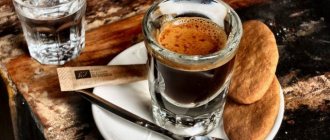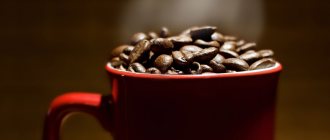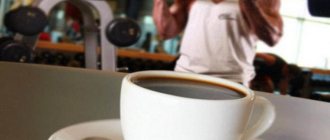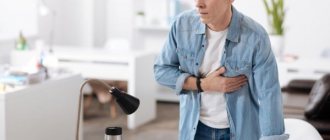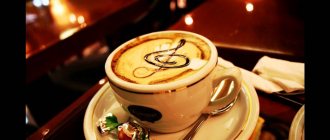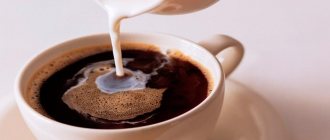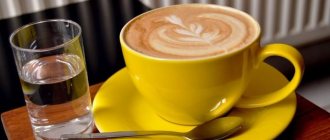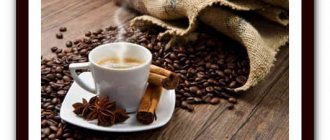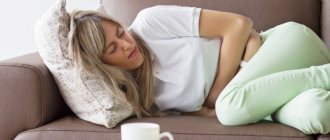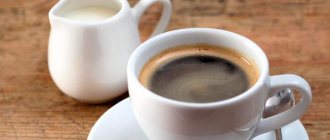People facing gallbladder resection surgery should know that from now on they need to reconsider their previous diet.
The therapeutic nutrition diet number “5” will allow you to restore the body, which will have to adapt to new conditions of the gastrointestinal tract.
Against the backdrop of these events, a question arises regarding whether it is worth drinking coffee after removal of the gallbladder or is it better to give it up forever?
This article will discuss exactly this invigorating drink, beloved by many, and the main nutritional points.
Why do doctors prohibit drinking coffee after surgery?
Caffeine and chlorogenic acids contained in coffee overstimulate the digestive system, stimulate the liver to secrete bile, and since there is no place to store it after surgery, this can be dangerous. With reasonable consumption of natural coffee and following a diet, problems usually do not arise, but doctors want to play it safe and therefore prohibit coffee as a drink altogether.
It is advisable to consult with your doctor before drinking coffee for the first time after surgery. The doctor has a better understanding of the patient's condition.
What is the reason for doctors' taboo on coffee?
Coffee contains chlorogenic acids and invigorating caffeine. They are able to influence the digestive system, causing it to secrete as much bile as possible in an excited state.
The liver promotes the secretion of secretory fluid, but if in a healthy body it accumulates in the gallbladder, then after cholecystectomy there is simply nowhere for it to be stored. All this can negatively affect a person’s condition.
If you drink natural coffee wisely and adhere to the established norms of dietary table No. 5, complications will be avoided.
True, doctors still try to play it safe, and therefore put coffee on the same list as prohibited products.
You should not drink coffee after cholecystectomy without consulting your doctor. If 2 weeks have passed and you decide to try this, you should pay attention to whether there is diarrhea, attacks of nausea, or sharp pain in the stomach.
Diarrhea when drinking coffee does not always appear immediately, although this phenomenon can occur even if a person does not drink it at all.
Due to caffeine and acids, the disorder will be enhanced. This suggests that only when the body starts working without failures can you start drinking coffee.
It should be noted that stomach upset can be caused not only by the presence of caffeine in the drink, but also by other substances that are released from the beans during roasting.
So don't think that you can start drinking decaffeinated coffee and avoid side effects. You need to be very careful with everything you consume after gallbladder removal, and not experiment with your health.
When can you try coffee?
About 2 weeks after surgery, you can try drinking some coffee. Signs that should alert you include stomach pain, nausea and diarrhea. Diarrhea may persist for some time regardless of coffee, but caffeine and acids can make it worse, so only drink coffee after gastric bladder removal if you feel well.
Diarrhea is caused not only by caffeine, but also by other substances that are released from the beans during the roasting process. So decaffeinated coffee will not help after gallbladder removal.
Danger: indigestion
Normally, bile is produced in the liver, enters the gallbladder, accumulates there, becoming more concentrated, and when eating food is thrown into the duodenum.
After surgery, bile is sent to the intestines directly from the liver, so its concentration is lower - it is only sufficient to digest small portions of food. If a person eats a lot, heaviness in the stomach and nausea occur. In addition, removal of the gallbladder leads to a decrease in the activity of digestive enzymes. How to avoid?
Take care of your liver . In the first months after surgery, choose boiled and steamed dishes, preferably pureed. Everything fried, fatty, spicy, and salty will have to be temporarily banned, as will alcohol. This will allow the digestive system to adapt to new conditions. After six months, the diet can be expanded to include fresh fruits and vegetables (except onions, garlic, radishes, lemons), fish and meat in pieces. After a year and a half, return to your usual diet. But it is better to abstain from refractory fats (for example, lamb or lard) and overly spicy foods for the rest of your life.
Chew slowly. The gradual intake of food into the stomach allows you to “wake up” the enzymes and gives the liver time to start working.
Take enzymes. After gallbladder removal, people often need medications to replace some of the missing enzymes. Contact a specialist and select the right product.
What kind of coffee can you drink after gallbladder removal?
In addition to coffee with milk, you may want to try other types. Be careful:
- Black coffee is prohibited. It can cause pain, bloating and diarrhea.
- Instant coffee in any form is prohibited. It contains too many preservatives, flavors, taste and smell enhancers, dyes and similar chemicals that are difficult for the body to perceive.
- You can drink natural coffee, but make sure that grounds do not get into the drink. Use either filters or a coffee machine.
- You can add spices.
- Drink no more than a cup of coffee per day.
Eating without a gallbladder
Diet No. 5, the observance of which is mandatory for all patients who have undergone cholecystectomy, is based on the principle of fractional nutrition. The essence of this principle is the frequent consumption (five or even six times a day) of small portions of food, observing equal (usually three hours) time intervals between meals. It is this kind of nutrition that does not allow bile to stagnate, and it is promptly and effectively removed from the body.
Another requirement of diet No. 5 is the principle of cooking. It is allowed to cook only by steaming, by boiling or baking foods. All food should be warm, since both hot and cold foods have a negative impact on the digestive system, which already works without the gallbladder under increased load.
Read also: What determines the color of gallstones?
Recommends drinking plenty of fluids, as this helps normalize bile flow. The daily drinking rate according to diet No. 5 should be one and a half to two liters per day. The drink should also be warm.
If we talk about possible foods for consumption, then such a diet involves avoiding fatty, fried, spicy and smoked foods. Meat broths, pickles, pickled foods, mushrooms, legumes, fatty fish, lard, pork, lamb, duck and goose meat, as well as alcoholic and carbonated drinks are prohibited. You should not eat sour fruits and berries, sweets, baked goods, cakes, pastries and ice cream. Avoid the use of sauces (mayonnaise, ketchup, etc.), as well as spices and herbs.
The basis of the diet should be:
- dietary meats (veal, chicken, rabbit, turkey);
- lean fish (pike perch, pike);
- soups with vegetable broth and porridges using buckwheat, rice, oatmeal and semolina;
- raw and boiled vegetables;
- sweet ripe fruits and berries;
- cottage cheese;
- low-fat fermented milk products;
- other healthy dietary products.
Sweets can be replaced with honey or dried fruits. It is recommended to use non-carbonated alkaline mineral water (Essentuki No. 4 and 17, Borjomi, etc.).
So, we have listed the general principles of proper nutrition after cholecystectomy, let’s move on to the main issue – coffee.
Why is cholecystectomy performed?
The gallbladder is an important organ necessary for normal digestion. It is a kind of reservoir in which bile accumulates (accumulates). Then the bile secretion, as needed, enters the duodenum and participates in the process of digesting food and absorbing instant vitamins and fats.
Diseases of the gallbladder (cholelithiasis, cholecystitis, cholangitis) lead to the organ gradually losing its functions. A non-functioning gallbladder poses a serious threat to health, as there is a risk of purulent inflammation and the development of peritonitis. A serious condition requiring immediate surgical intervention also occurs when the bile duct is blocked by a stone.
Removing the gallbladder helps avoid serious health consequences. Today, almost no abdominal surgeries are performed, resorting to the laparoscopy method, when the affected organ is removed through a small puncture in the abdominal cavity. This helps to minimize postoperative complications and significantly shorten the rehabilitation period.
The life of a person with a removed gallbladder is absolutely complete and differs from the life of an ordinary person only in that after the operation he will have to adhere to a certain diet, since the removal of an important organ changes the very pattern of digestion. This means that the diet after cholecystectomy must be strictly followed; without it, the patient’s remission is impossible. It should become a part of life, but in no case should it be perceived as some kind of sentence or a state of inferiority.
What happens after surgery?
After surgery to remove the gallbladder, the liver continues to produce bile, but the reservoir in which it is stored is no longer there. Therefore, the load falls on the bile ducts. Of course, they do not perform the functions of a remote organ, but only direct bile from the liver to the digestive system. Since the produced bile has nowhere to accumulate, its concentration decreases and it enters the intestines constantly, in a “diluted” form and in large volumes.
Such a change can be fraught with inflammation of the bile ducts and duodenum. In addition, since bile has nowhere to concentrate, the amount of enzymes responsible for the breakdown of fats is much lower. This point must be taken into account by the diet after surgery to remove the gallbladder.
How to eat properly after surgery?
For people living with a removed gallbladder, two dietary rules should become an axiom:
- you need to eat often and little by little, so that the bile in the intestines does not stagnate, but is immediately consumed;
- food should not be heavy and fatty, so that the low level of bile concentration is enough for its breakdown and absorption.
As for the nutritional plan itself, it depends on two factors:
- from the time that has passed since the day of the operation;
- from the way in which the cholecystectomy was performed.
Diet after laparoscopy
This method of organ removal is the most modern and least traumatic. The patient, as a rule, is discharged already on the 3rd day after the operation, but the diet after removal of the gallbladder by laparoscopy implies the same restrictions as during a conventional surgical operation.
On the first day after surgery, you should not only eat food, but also drink water. You can only moisten your lips with a damp cloth or rinse your mouth with herbal decoctions. Then the patient is gradually allowed to drink a little (rosehip decoction, boiled water) and after three days they gradually begin to introduce permitted foods into the diet. Then the patient must follow a strict 5a diet and adhere to fractional meals. That is, eat little and often (5-6 times a day) at the same hours. Basic principles of diet after gallbladder removal:
- Maximum gentle. This means that all dishes are served pureed and boiled, which facilitates the digestion process.
- Heat treatment. Dishes are steamed, boiled, stewed or baked. This cooking method, such as frying, is completely excluded. All dishes must be heat treated; heavy foods, vegetables and fruits with coarse fiber are excluded.
What products are prohibited?
Recipes for a diet after gallbladder removal are different and varied; a nutritionist will always help you develop and select the optimal menu option for every day. Therefore, you shouldn’t get too hung up on the list of dishes, but you need to remember which foods should be permanently excluded from the diet:
- spices, herbs;
- onion;
- radish;
- garlic;
- radish;
- mushrooms;
- fat meat;
- salo;
- beef, lamb and duck fats;
- smoked and semi-smoked sausages:
- fatty meats and fish;
- carbonated drinks;
- confectionery (cakes, pastries), sweets;
- baked goods;
- peas, beans;
- ice cream;
- jellied meats, jellied dishes;
- instant noodles;
- the entire range of fast food;
- pickled and canned vegetables;
- fish roe;
- meat of ducks, geese, game and hunting products, for example, meat of elk, bear, etc.;
- a complete ban on alcohol.
As for other restrictions, in addition to the method of processing food, its temperature is also important; it should not be hot or cold, that is, dishes should be served warm.
First week without gallbladder
The most severe and psychologically difficult moments of dietary and lifestyle restrictions are the diet after removal of the gallbladder in the first days after surgery. It includes an eight-day adaptation of a person to new processes in physiology:
- First day. Within 24 hours after completion of the operation, there is a complete ban on eating, including drinking. In fact, this is not as scary as it seems, because most of this time the patient sleeps.
- Second day. You can drink warm boiled water, rosehip decoction and dried fruits without sugar (no more than 150 ml at a time).
- The third day. Add pumpkin, carrot or beet juice, half diluted with water, low-fat kefir, unsweetened and weak tea.
- Fourth day. You can gradually include liquid vegetable purees and pureed vegetarian soups in your diet. The amount of food per meal should not be more than 100 grams, and you need to eat 8-10 times a day.
- Fifth day. Day-baked wheat bread, biscuits, boiled pureed vegetables, and low-fat steamed fish are added to the diet.
- Sixth day. You can add porridge, oatmeal, millet, and buckwheat to the menu. Porridges should be well boiled in water and pureed.
- Seventh day. You can start eating all low-fat fermented milk products, fruit and vegetable purees (baby food), and minced chicken meat products (steamed dumplings, cutlets, soufflé).
- Eighth day. Portions are gradually increased, but not more than 200 grams per meal, and the number of meals per day is reduced to 6-8.
Recommendations from experts
- You can drink coffee only 1 hour after eating, if you really want to. The best option is to eat at 9.30 and drink an invigorating drink before 11.30. You can dilute it with water, but you need to add a little full-fat milk. The volume should be no larger than an average cup.
- The initial intake of coffee after surgery should be no more than a couple of sips in volume. The body has gone without caffeine for a long time, and therefore even this amount will contribute to vigor.
- Coffee with milk is allowed. But you need to know that black coffee can cause pain, diarrhea and severe bloating, but you should not drink instant coffee at all. It contains a lot of flavor enhancers, flavors, dyes and other preservatives. It will not be easy for the body to cope with them after cholecystectomy, and there is no need to expose it to such a risk.
- Drink natural coffee, but always without grounds. It is better to use special filters or a coffee machine for these purposes.
- It is allowed to add spices to coffee.
- The daily intake of coffee after cholecystectomy is no more than 200 grams.
To drink or not to drink
Give a clear answer to the question: “Is it allowed to drink coffee after gallbladder removal?” - will not work.
It should be noted that you definitely cannot drink it in the first 14 days after the operation. Subsequently, coffee after removal of the gallbladder is allowed, but in small quantities and provided there is no discomfort. This drink is nothing to joke about, because it can worsen the condition.
In any case, when removing a bubble, a person needs to treat coffee carefully and in no case ignore the signals from his body that give a sign that something has gone wrong.
The effect of coffee on the gallbladder
Coffee has an ambiguous effect on the gallbladder and other organs. When using it, there may be benefits and harm. The effect largely depends on the condition of the organ.
Coffee drinks stimulate contraction of the walls of the gall sac and provoke intense production of bile. In the presence of stagnant processes, there is a positive effect. Coffee prevents the formation of stones and the development of cholecystitis. It has been scientifically proven that the risk of these pathologies is reduced by 45%.
However, in the presence of stones in the bladder, a completely different effect is observed. Espresso is not able to dissolve them. Due to additional stimulation of motility, the walls of the organ are damaged and the bile ducts become clogged. As a result, the inflammatory process begins.
